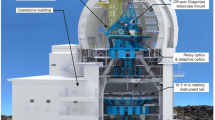Abstract
When it began operating in 1975, the Anglo-Australian Telescope set new standards for pointing, tracking, and efficient observing. Since then, several large telescopes with more advanced control systems and on better sites have come into competition but the AAT retains the reputation of having the best overall observing efficiency.
A number of organizational factors in the design and construction phase and in the Anglo-Australian Observatory's operational years have contributed to the AAT's success. Careful consideration of these factors should help groups planning the construction and operation of new telescopes.
Similar content being viewed by others
Author information
Authors and Affiliations
Rights and permissions
About this article
Cite this article
Gillingham, P.R. Lessons for new large telescopes from the AAT. Astrophys Space Sci 160, 281–286 (1989). https://doi.org/10.1007/BF00642783
Received:
Issue Date:
DOI: https://doi.org/10.1007/BF00642783




